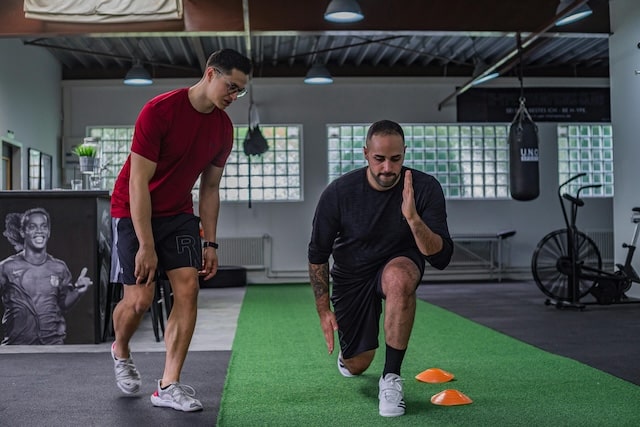Lunge Variations & Progressions: From Beginner to Advanced
Whether you’re just starting your fitness journey or looking to challenge yourself further, these lunge variations will help you achieve your lower body strength and stability goals.
Lunges are one of the most effective exercises for building lower body strength, stability, and mobility.
They offer a variety of benefits, including improved muscle balance, enhanced coordination, and increased joint flexibility.
By incorporating these lunge variations into your routine, you’ll not only improve your physical performance but also reduce your risk of injury and enhance your overall fitness.
Remember, consistency is key, so keep challenging yourself and progressing through these variations to see the best results.
Whether you’re a beginner or a seasoned athlete, understanding these lunge variations will help you take your lower body training to the next level.
Why Should You Do Lunge Variations?
Lunge variations are not just about adding variety to your workout—they play a crucial role in building functional strength.
Each variation targets different muscles and movement patterns, helping to improve overall athletic performance and reduce the risk of injury.
Additionally, by gradually increasing the difficulty of your lunge exercises, you can continue to challenge your muscles, leading to greater gains in strength and endurance.
Best Lunge Variations
That you have a better understanding of the importance of lunge variations, here are the best lunge variations:
Reverse Lunge
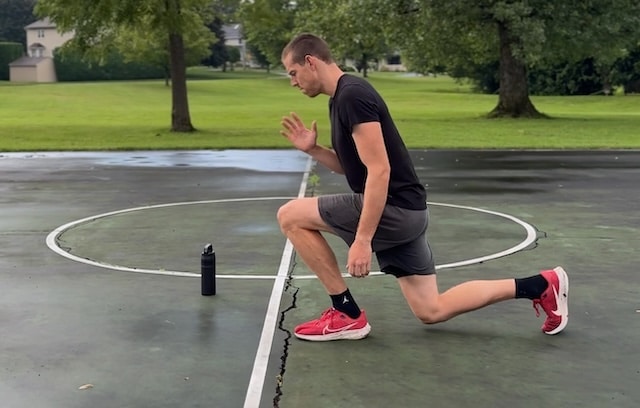
The reverse lunge is often considered the best starting point for those new to lunges. Unlike the forward lunge, where you step forward, the reverse lunge involves stepping backward.
This movement places less stress on the knee joint, particularly on the patellar tendon, making it a safer option for beginners or those with knee concerns.
The reverse lunge primarily works the quadriceps, glutes, and hamstrings, helping you build a strong foundation of lower body strength.
How to Perform a Reverse Lunge:
- Stand with your feet hip-width apart.
- Take a step back with your right foot, lowering your hips until both knees are bent at a 90-degree angle.
- Push through your left heel to return to the starting position.
- Repeat on the other side.
Muscles Worked: Quadriceps, glutes, hamstrings.
Forward Lunge
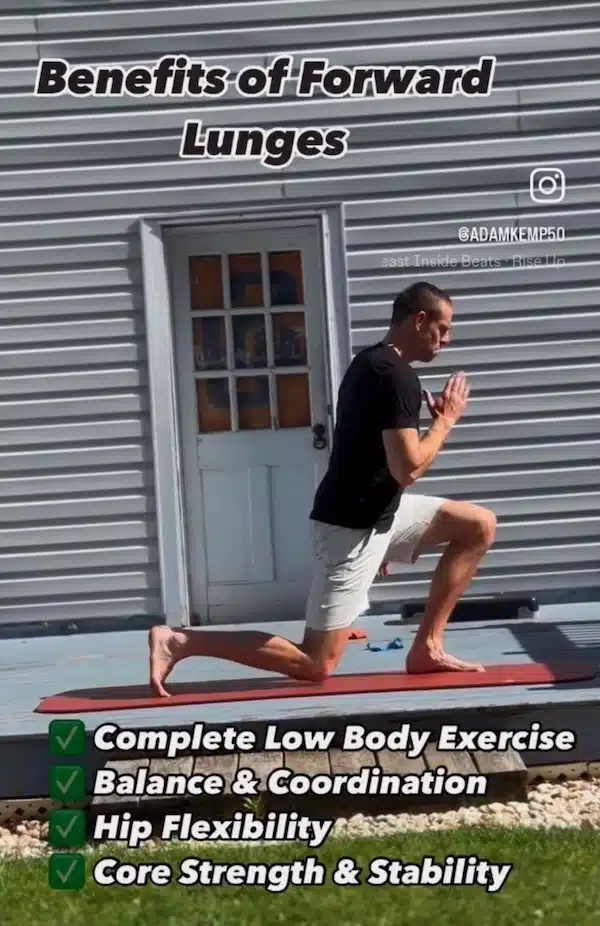
Once you’ve mastered the reverse lunge, the forward lunge is the next logical progression. The forward lunge requires you to step forward, which increases the load on your front leg, particularly the quadriceps and glutes.
This variation also challenges your balance and coordination, as you must control your body weight as you move forward.
The forward lunge is a great exercise for improving lower body strength and stability, and it can be easily modified by adding weights or increasing the step length.
How to Perform a Forward Lunge:
- Stand with your feet hip-width apart.
- Take a large step forward with your right foot, lowering your hips until both knees are bent at about 90 degrees.
- Push through your right heel to return to the starting position.
- Repeat on the other side.
Muscles Worked: Quadriceps, glutes, hamstrings, calves.
Lateral Lunge
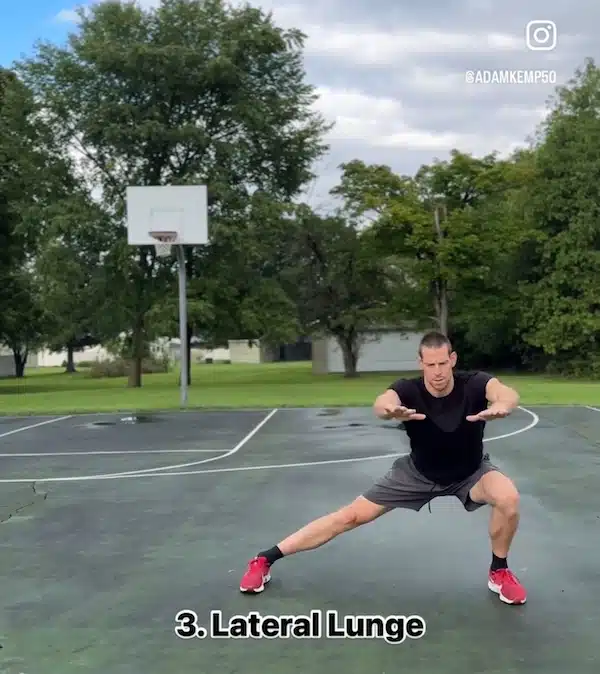
The lateral lunge adds a new dimension to your workout by introducing side-to-side movement, which is often neglected in traditional lower body exercises.
This variation targets the adductors (inner thigh muscles) and glutes, making it ideal for improving hip mobility and strengthening the muscles that support lateral movements.
Incorporating lateral lunges into your routine can help enhance your agility, balance, and overall athletic performance, especially in sports that require quick side-to-side movements.
How to Perform a Lateral Lunge:
- Stand with your feet hip-width apart.
- Take a big step to the right, bending your right knee and pushing your hips back as you lower into a lunge.
- Keep your left leg straight and your chest up.
- Push through your right heel to return to the starting position.
- Repeat on the other side.
Muscles Worked: Glutes, adductors, quadriceps, hamstrings.
Curtsy Lunge
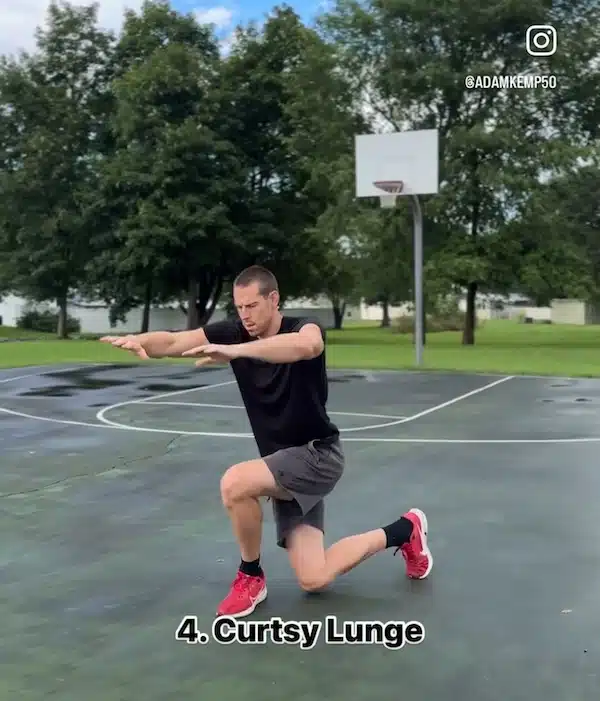
The curtsy lunge is the most advanced of the lunge variations discussed here. By stepping your leg diagonally behind you, the curtsy lunge places a unique demand on your glutes, quads, and inner thighs.
This variation not only challenges your balance and coordination but also requires significant lower body strength to perform correctly.
The curtsy lunge is an excellent finishing move for a lower body workout, helping to develop the smaller stabilizing muscles that are often overlooked in traditional exercises.
How to Perform a Curtsy Lunge:
- Stand with your feet hip-width apart.
- Step your right leg diagonally behind your left leg, lowering your hips until your left thigh is nearly parallel to the floor.
- Keep your chest up and your weight centered over your left leg.
- Push through your left heel to return to the starting position.
- Repeat on the other side.
Muscles Worked: Glutes, quadriceps, adductors, hamstrings.
How to Increase the Difficulty of Lunge Variations
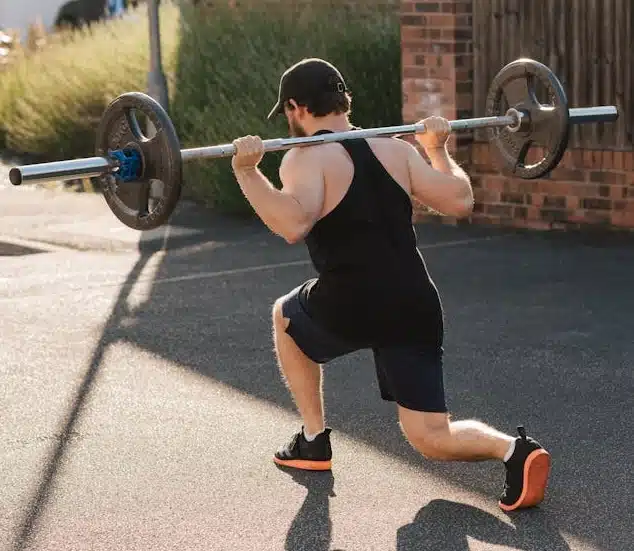
Once you’ve mastered the basic lunge variations—reverse lunge, forward lunge, lateral lunge, and curtsy lunge—there are several ways to increase the difficulty and continue challenging your muscles.
By adding weight, incorporating different equipment, or modifying your technique, you can make lunges more intense and effective. Here are some strategies to elevate your lunge game:
Adding Weight: Dumbbells, Kettlebells, and Barbells
One of the most straightforward ways to increase the difficulty of lunges is by adding weight. Incorporating dumbbells, kettlebells, or a barbell into your lunges not only increases the resistance but also engages your core and stabilizing muscles more effectively.
- Dumbbell Lunges: Hold a dumbbell in each hand, letting them hang by your sides as you perform your lunge variations. This added resistance forces your muscles to work harder, leading to greater strength gains.
- Kettlebell Lunges: You can hold a kettlebell in one hand or both hands at chest level (in a goblet position). The uneven load of a single kettlebell will challenge your balance and core stability.
- Barbell Lunges: Place a barbell across your shoulders as you lunge. This variation requires significant core strength and stability to maintain proper form throughout the movement.
Tip: Start with lighter weights to ensure you maintain proper form, then gradually increase the load as your strength improves.
Slide Lunges: Engaging More Muscles
Slide lunges, also known as gliding lunges, involve using a sliding disc, towel, or paper plate to glide one foot across the floor as you perform the lunge.
This variation adds an extra challenge by requiring more control and stability, particularly from your core and inner thigh muscles.
- Reverse Slide Lunge: Place one foot on a sliding disc and perform a reverse lunge, allowing the disc to glide backward as you lower into the lunge. This variation emphasizes the eccentric (lengthening) phase of the movement, which is crucial for building strength and muscle control.
- Lateral Slide Lunge: Stand with one foot on a sliding disc and perform a lateral lunge, letting the disc slide out to the side as you lower your hips. This movement places a greater emphasis on your adductors and glutes, challenging your ability to control the movement laterally.
Tip: Keep the movement slow and controlled to maximize the engagement of stabilizing muscles and prevent injury.
Elevating Your Rear Foot: Bulgarian Split Squats
The Bulgarian split squat is a variation of the lunge that involves elevating your rear foot on a bench or step, which increases the difficulty by placing more emphasis on the front leg.
This variation is excellent for isolating the quads and glutes while challenging your balance and coordination.
How to Perform a Bulgarian Split Squat:
- Stand a few feet in front of a bench or step.
- Place the top of your rear foot on the bench behind you.
- Lower your hips into a lunge position, keeping your front knee over your ankle.
- Push through your front heel to return to the starting position.
Tip: To further increase the difficulty, you can add weight by holding dumbbells or a barbell.
Jump Lunges: Adding Plyometric Power
Jump lunges are a plyometric variation that adds an explosive element to your workout. This variation increases the intensity by incorporating a jump between lunges, which boosts your heart rate and engages fast-twitch muscle fibers.
How to Perform Jump Lunges:
- Start in a lunge position with one foot forward and one foot back.
- Jump into the air, switching legs mid-air so that you land in a lunge position with the opposite leg forward.
- Immediately jump again, alternating legs with each rep.
Tip: Focus on landing softly to protect your joints and ensure proper form.
Combining Lunges with Other Exercises: Compound Movements
For an even greater challenge, you can combine lunge variations with other exercises to create compound movements that engage multiple muscle groups simultaneously.
- Lunge to Bicep Curl: Perform a lunge while simultaneously curling dumbbells up to your shoulders. This combination works your lower body and arms together.
- Lunge to Shoulder Press: Combine a lunge with an overhead press to engage your lower body, core, and shoulders in one fluid movement.
- Lunge to Row: Pair a reverse lunge with a bent-over row to target your back and legs at the same time.
- Lunge-Step Up: Perform a reverse lunge and then go directly into a step up. This is a great burner for your quads and also helps improve coordination and proprioception for added force-power transfer training.
Note: Compound movements are excellent for time-efficient workouts, as they engage multiple muscle groups and improve overall coordination.
Read Next: Best Bodyweight Leg Exercises

